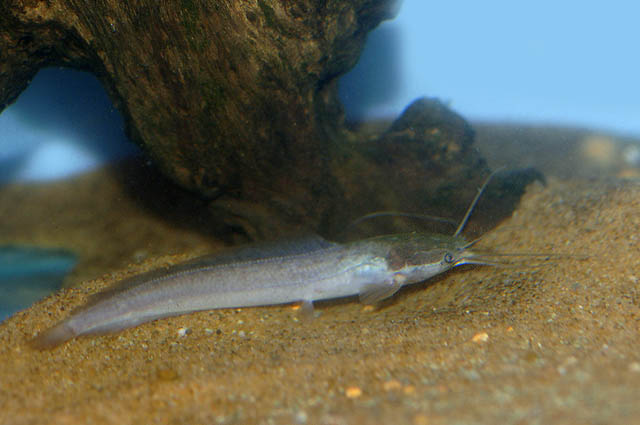| Clariidae (Airbreathing catfishes) |
| 46.6 cm TL (male/unsexed) |
|
demersal; freshwater |
| Africa: from Volta basin in Ghana (Ref. 57129) and coastal rivers in Togo to the lower and middle Congo River basin (Ref. 248); also reported from the upper Congo (Ref. 106245). Widespread in Lower Guinea, from the Cross in Nigeria and Cameroon to the Loémé in Republic of Congo (Ref. 81644). |
|
Dorsal spines (total): -0; Dorsal soft rays (total): 69-94; Anal soft rays: 52-70; Vertebrae: 56-61. Diagnosis: body less elongate, its maximum depth 11.9-16.4% SL (m=14.1); head length 21.0-26.0% SL (m=24.1) (Ref. 57129, 81644). Head rectangular dorsally; snout extremely broadly rounded; eyes more laterally placed (Ref. 248). Interorbital distance 45.4-54.3% HL (m=48.8) (Ref. 57129, 81644). Tooth plates extremely broad (Ref. 248), width of premaxillary tooth plate 30.4-38.9% HL (m=34.9), and of vomerine tooth plate 26.1-33.9% HL (m=29.7)(Ref. 57129, 81644). Frontal fontanel long and narrow; occipital fontanelle long and oval-shaped (Ref. 248). Supraorbital and "dermosphenotic" bones separated in specimens up to 200 mm SL, in larger specimens they usually become joined (Ref. 248, 101841)). 7-13 (Ref. 57129, 81644) or 7-14 (Ref. 101841) gill rakers on first gill arch. Suprabranchial organ well developed (Ref. 248, 101841). Pectoral spine slender, its outer side showing strong downward serrations (Ref. 248, 81644). Dorsal fin length 59.5-67.9% SL; distance from dorsal to caudal fin 1.2-4.3% SL (Ref. 57129, 101841). Flank neuromasts arranged in a regular pattern (Ref. 81644).
Colouration: no information on colour in life (Ref. 57129, 101841). Preserved specimens: dark brown on back and sides and pale brown to beige/whitish on belly; pectoral and pelvic fins sometimes with a pale distal band; caudal fin sometimes with alternating light and dark vertical bars (Ref. 57129, 81644). Never an irregular pattern of small white spots on body (Ref. 101841). |
| Data on the diet of C. walkeri (=C. camerunensis) showed larvae of mayflies, chironomids, and caddis insects to be the main food of small and middle-sized specimens (Ref. 248). Stomach content analysis showed presence of practically everything edible from plant remains, insects and their larvae to fish remains (Ref. 78218). |
|
Least Concern (LC); Date assessed: 29 April 2019 Ref. (130435)
|
| harmless |
Source and more info: www.fishbase.org. For personal, classroom, and other internal use only. Not for publication.

